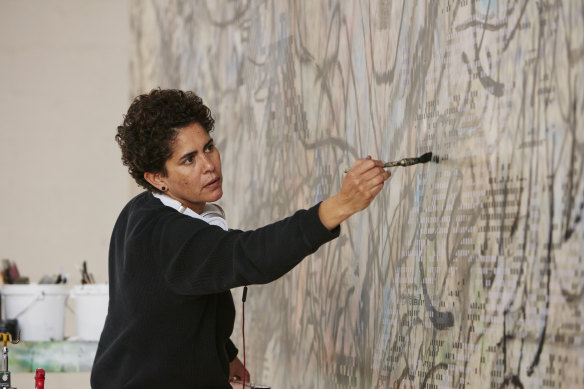
Julie Mehretu at work on HOWL, eon (I, II), 2017 commissioned by the San Francisco Museum of Modern Art.Credit: Tom Powel Imaging
Julie Mehretu is having a golden year. In March, the Ethiopian-born New Yorker opened her biggest show to date at Venice’s lush Palazzo Grassi art museum, owned by French luxury goods billionaire turned art collector Francois Pinault. The 53-year-old then swiftly moved back to work on the design and execution of 35 abstract, painted glass panels for the Obama Presidential Centre, a new museum that will anchor a sprawling 19-hectare urban renewal project in Chicago’s historic Jackson Park.
Both ventures have been labours of love for the abstract painter. Mehretu is a favourite of former president Barack Obama, who described her “on point” stained-glass design as one of “the most important aspects” of the library and museum civic complex being constructed in his honour.
This workload explains why, when we catch up via a Zoom call to Mehretu’s New York studio, the protostar of the international art world is still finishing new paintings destined for what will be her debut solo survey exhibition in Australia at Sydney’s Museum of Contemporary Art this summer.
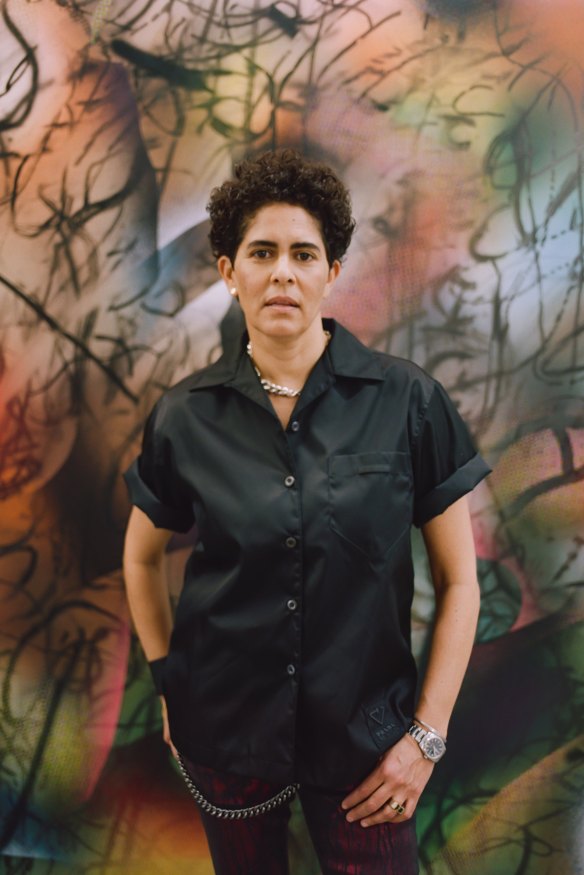
Julie Mehretu is coming to the Museum of Contemporary Art.Credit: Josefina Santo
Mehretu exudes calm, or possibly tired distraction at the end of a day in the studio. It’s early morning in Sydney and after 5pm in New York. There’s a hint of busyness in the background, with an assistant off-screen who occasionally prompts her when she cannot find the word she is looking for or needs to clarify a detail.
The act of balancing the presentation and promotion of her art with time working in the studio and opportunities to gain inspiration is still a work in progress.
“This last year was challenging … I wasn’t able to paint and get lost in the studio in the early part of the year. It was too demanding with the show in Venice and the stained-glass installation for the Obama presidential centre,” she says. “Towards the end of the academic year, in June, I was able to get back into it and I’m trying to be more attentive to protecting that space.”
The new paintings are winging their way to Sydney for Julie Mehretu – A Transcore of the Radical Imaginatory, which will feature paintings of Mehretu’s from 2017, alongside inks, charcoals and other works on paper that reveal her artistic development from 1996.
MCA director Suzanne Cotter describes Mehretu’s chosen exhibition title as “poetic”. “Not unlike hip hop and music-sampling, and the idea of going beyond what we already know to imagine a better world – radical,” she says.
So what exactly are we looking at?
‘It’s insane. Going to Australia, you get a sense of how large this world is.’
Julie Mehretu
Mehretu’s paintings often begin with blurred photographs which create what she calls “the social ground” of the artwork. They reverberate with expression, allowing the viewer to make of them what they will, in doing so they offer a nod to another New York abstract painter, Jackson Pollock, whose landmark painting Blue Poles divided our nation when it was acquired by the Whitlam Government in 1973 for $1.4 million. Half a century later, Blue Poles still divides Australians, although it is valued at $500 million.
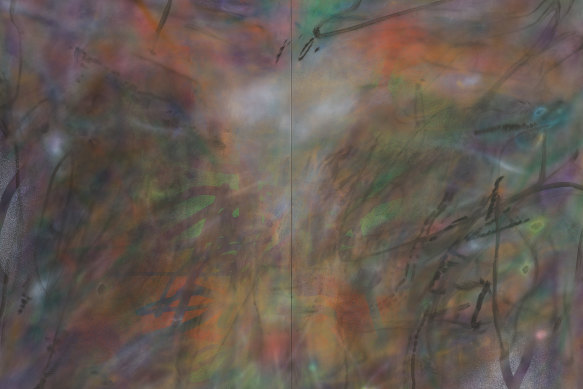
Core Fragment (echo), 2018.Credit: Tom Powel Imaging
“Her paintings will transcend time,” Cotter says of Mehretu.
To understand her art, it is helpful to look at her unusual upbringing.
Mehretu is the eldest daughter of an Ethiopian university professor and a white American teacher who met as students in the US and had settled in Ethiopia’s capital, Addis Ababa, by the time she was born in 1970. In 1977, the family, which by then included three children, moved to Michigan following a military conflict that resulted in a dictatorship.
Mehretu’s father obtained a position teaching economic geography at Michigan State University, her mother secured a teaching role in a Montessori school and the young Julie settled easily into school. It wasn’t until her final year at university that she thought she could forge a career as an artist. The mapping iconography of her childhood on the move and her father’s life work is a hallmark of her early output.
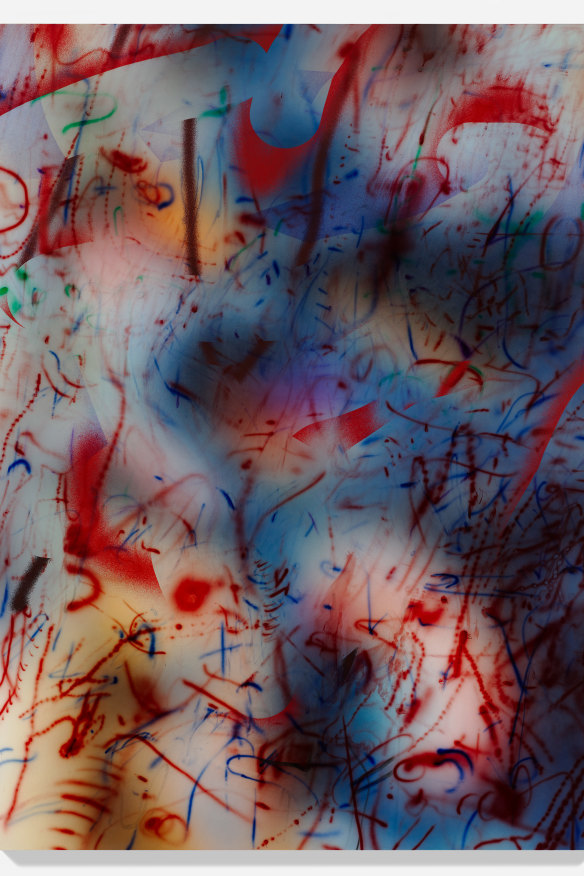
Rise (Charlottesville), 2018–2019.Credit: Tom Powel Imaging
Mehretu has returned to Africa at various times to better understand her origins. She has also spent time in Australia, exploring the outback on camping trips and travelling to remote wilderness locations. She has regularly visited the bigger cities of Sydney and Melbourne, owing to the years spent, and two sons she shares with her ex-wife, Australian-born fellow New York artist Jessica Rankin.
“It’s been really formative, those trips sleeping in the middle of nowhere and waking up with those big birds, emus, walking by. It’s insane. Going to Australia, you get a sense of how large this world is,” Mehretu says.
Cotter says Mehretu’s interest as a person and artist resonates strongly in Australia.
“She’s part of a conversation in the world and part of a way of thinking about, let’s call it the black imaginary identity. That is, this question of black subjectivity, which is incredibly important in her work and very much present in the art of First Nations peoples in this country,” Cotter says.
Where Mehretu’s recent oeuvre builds on blurred photography, she made her name in New York in particular with large-scale, detailed and layered abstracts featuring architectural and geographical images.
The style is most spectacularly evident in her seven-metre high, 24-metre long installation Mural unveiled in 2009 with little fanfare in the New York HQ foyer of merchant bank Goldman Sachs.
The painting on canvas is made up of intersecting colourful abstract forms influenced by images of trade routes, maps and photographs referencing the history of global economies and the financial industry.
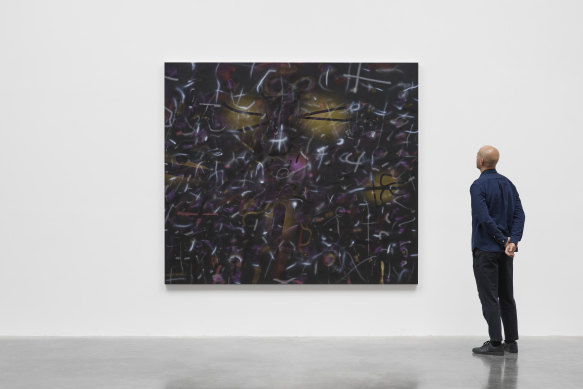
Femenine in nine, part 5, 2023.Credit: White Cube
Mehretu’s design was influenced by French historian Fernand Braudel’s observations of Western capitalism, and she worked with a team to create detailed architectural drawings that have been made more complex in the work by layering with a clear silica-and-acrylic solution. Upon completion, each layer was sanded back to create a lush texture.
The 25-metre canvas, which sits within the bank’s foyer and is visible to the public, triggered debate about whether the work was a self-indulgent trophy for the bank or a worthy contribution to public art; the New Yorker published a deep-dive article headlined Big Art, Big Money.
What was far more contentious in 2009 was the fact of its existence at all. Mehretu had successfully bid for the $US5 million commission in 2007, then worked on it with a team of assistants in the ensuing two years of the global financial crisis. By the time it was finished, Goldman Sachs had become a global pariah accused of falsely assuring investors that securities it sold were backed by sound mortgages, when the bank knew they were likely to fail (in 2016, the US Justice Department found Sachs accountable for serious misconduct; the bank was fined $US5 billion).
The GFC might have robbed Mehretu of her big reveal celebration, but the artwork triggered debate about her depiction of capitalism at a time when the system was faltering. In doing, it cemented her reputation as an artist of note. In the following years she adapted her architectural and mapping style for explorations of world events including the Arab Spring.
Her current inspiration is varied.
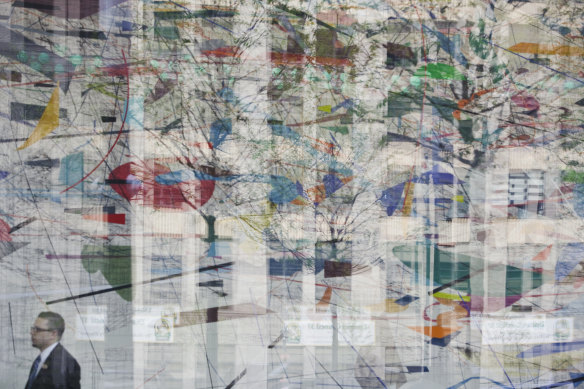
People walk past the $5 million mural by Julie Mehretu inside the Goldman Sachs headquarters.Credit: James Leynse/Corbis via Getty Images
“It’s usually some form of travel,” she says, coupled with the routine necessary for child-rearing “that’s really grounding”.
“Reading really helps. Right now I’m reading Rebecca Solnit’s Orwell’s Roses, Doris Lessing’s The Golden Notebook, Yuval Noah Harari’s Nexus: A Brief History of Information Networks from the Stone Age to AI and I’m trying to reduce my news consumption,” she says, resisting being substantively drawn on the US election.
“I’m definitely not ignoring it. I’m trying to do a lot of work to ensure we don’t wake up to a shitty reality, I’m trying not to get too worried but it’s complicated, right? We’re living more and more in a dystopic reality collectively in the world as technology around how information is shared has really shifted,” she says.
Among the paintings on display at the MCA will be a series anchored with blurred images of bushfires.
“From Australia to Brazil to California, there are so many forms of similar action repeated across the world. Likewise extreme violence seen in the Ukraine, Israel-Palestine, as well as violence on the border in this country and the history of violence in Australia as well. Those tendencies are what I struggle to make sense of, repeating patterns,” she says.
“We should all be smarter. Those bigger complexities and challenges, of how do we invent language to challenge this stuff and how do we invent spaces for liberation, this is what I’m trying to interrogate in painting.”
A Transcore of the Radical Imaginatory is not Mehretu’s first outing at the MCA. Sydney Biennale curator Charles Merewether included her untitled collaboration with Stephen Vitiello – which consisted of hanging speakers pulsing subsonic sounds and a painting Mehretu’s created in response – in his 2006 program.
That Biennale included several artists who are now giants in the contemporary art world. Mehretu is holding her own among them.
Julie Mehretu: A Transcore of the Radical Imaginatory is at the Museum of Contemporary Art from November 29 to April 27.